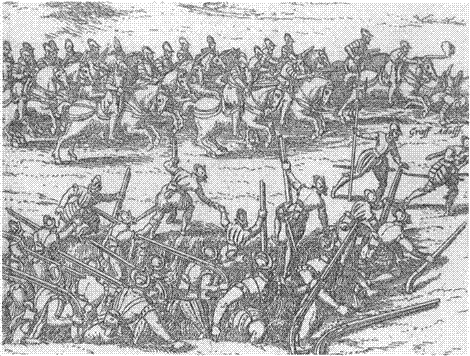increasingly the Kossmanns were feeling that their children should grow up in the Netherlands, and in 1966 he accepted the Chair in Modern Dutch History at Groningen University, where he remained until his retirement in 1987. During these decades his wideranging scholarly publications continued to flow, and his home continued to tempt friends and scholars to make the journey to the North-Eastern Netherlands.
Kossmann's reputation as a historian rests, first of all, on his work on political theory and thought in the Dutch Republic. His short monograph of 1960 was a classic, a ground-breaking study of the important but largely disregarded writings of political thinkers like De la Court, Vander Muelen and Ulrich Huber. In 1974 this was followed by his Texts Concerning the Revolt of the Netherlands, an extremely valuable collection of pamphlets justifying the Dutch Revolt between 1565 and 1588, for which he wrote a long introductory essay that is justly considered a masterpiece. In translation we now have his Political Thought in the Dutch Republic. Three Studies (2000), which shows us Kossmann as an Ideenhistoriker in the best tradition of Friedrich Meinecke, while at the same time offering a very Dutch, soberminded and critical examination of the historical documents and the republican ideas they contain. The realism and scepticism of Kossmann's approach also meant, however, that he kept his distance from the newer intellectual history of Skinner. Pocock and the Cambridge School, with their emphasis on language, rhetorical analysis and philosophical traditions.
Beyond the Dutch Golden Age, Kossmann also made important contributions to the history of political thought in the eighteenth century, with his study of the conservative thinker Elie Luzac, and in the nineteenth century, in his study of the liberal statesman and reformer Thorbecke, published in 1982. Ranging far and wide, Kossmann was perhaps the last historian who was at home in any period of modern Dutch history, as we can see in the standard work he published in 1978, The Low Countries, 1780-1940, first commissioned by Oxford University Press in 1960. In 1986 this was expanded into a two-volume work in Dutch which brought the account up to 1980.
This trailblazing double-portrait of the modern history of the Netherlands and Belgium is a model of comparative history writing, which brings out both

The early days of the Dutch Revolt: Dutch foot soldiers and German cavalry launching an attack on the Spanish during the Battle of Heiligerlee (1568). Engraving by Frans Hogenberg.
the common themes and the many differences between the two neighbouring states. The book, at once scholarly and very readable, is full of well-chosen
apercus that challenge accepted views and open up new vistas for historical research. It was a set text for generations of students who benefited from Kossmann's quite brilliant capacity to synthesise historical debate. It was a much-valued companion to
The Literature of the Low Countries (1978) by the then Professor of Dutch Language and Literature in the University of London, Reinder Meijer. Taken together, these two works cover the whole range of literature, culture, history and politics of the Netherlands and Belgium, and they leave an enduring legacy of solid scholarship that will not easily be surpassed. They stand out in a distinguished tradition of Dutch Studies in London, which began in 1919 with Pieter Geyl, and runs via Gustaaf Renier, Koen Swart and Jonathan Israel through to the new holder of the Chair, Benjamin Kaplan, who gave his inaugural lecture at UCL on the day after Kossmann's funeral.
Over the years, Kossmann also published a formidable number of essays - vignettes of prominent historians such as Meinecke, Werner Kaegi, Ranke,